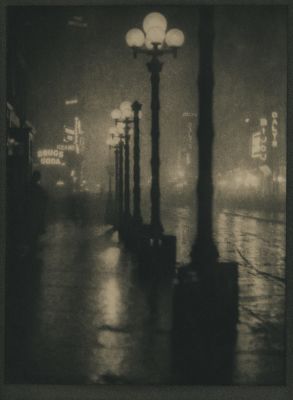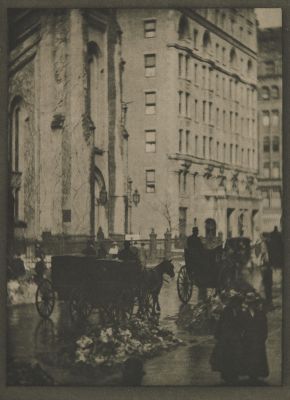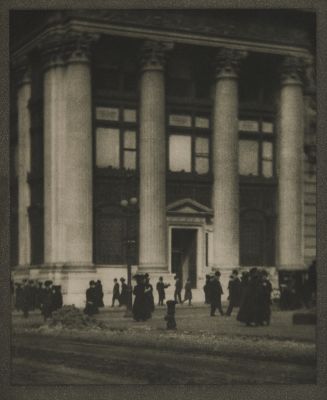
Title
The Tunnel BuildersArtist
Coburn, Alvin Langdon (American, 1882-1966)Key FigurePublication
New YorkDate
1913Process
PhotogravureAtelier
Alvin Langdon CoburnImage Size
21 x 17 cm
“I think I may claim that in my hands photogravure produced results which can be considered as “original prints,” and which I would not hesitate to sign… I prepared the printing plates myself, by etching and steel-facing them; I ground the inks and pulled proofs on various grades of paper until I had a specimen for my printer to follow…no-one will ever know save those who have experienced it, what such an undertaking involves.” (Alvin Langdon Coburn)
Alvin Langdon Coburn was already an accomplished photographer when in 1902-03 he studied in Ipswich, Massachusetts, with the Arts and Crafts printmaker and educator Arthur Wesley Dow. In 1904, he studied wood-engraving in London with the painter-etcher Frank Brangwyn, where he experienced the etching process first hand and was influenced by Brangwyn’s social commitment to the industrial worker in the urban landscape. In 1906, he attended London County School of Photo-Engraving, bought his own etching press, and became a photographer-gravurist.
Printing his original hand-pulled gravures in his books London (1909) and New York (1910), Coburn was effectively refuting the contention of etcher-critic Joseph Pennell (student and biographer of Whistler), in his 1897 article ‘Is Photography Among the Fine Arts?’, that images produced by the mechanism of the camera could not approach the status of art.
The challenge for the artist-photogravurist was to re-introduce, into the technical constraints of photography and gravure, elements of personal artistic control. The photogravurist could, by control of contrast of inking in the photogravure, prioritize the most important elements and suppress or exclude less important ones. This idea is directly related to Haden and Hamerton’s concept of selection and omission in etching, the artistic emphasis through structure and tone, and refined economy of expression (Hammond)
Wells
"New York intro:
Posterity will owe much to Mr. Coburn, so that I hesitate to call the series of studies he has made of the beauty of contemporary cities the chief thing for which his memory will be honoured; but certainly his record of urban effects will be a greatly valued legacy. Our time will go to our descendants heavily and even over-abundantly documented, yet I still fancy these records of atmosphere and effect will gleam, extremely welcome jewels, amidst the dust-heaps of carelessly accumulated fact with which the historian will struggle. Mr. Coburn has already done his share in recording that soft profundity, that gentle grey kindliness, which makes my mother London so lovable, that tenderness which otherwise will seem so incredible in an age that will know nothing of carbon-laden fog-veils and sooty bricks and the blackened stems of trees against the spring. And now here he has set himself with the finest discrimination to give in a compact volume the hard. clear vigour of New York, that valiant city which even more than Venice rides out upon the sea.
I will confess an unqualified admiration for the sky-scraper—given the New York air to reveal it clearly to its summit against the sky. The Flat-iron visited again and again during my brief stay in New York, that I might see it at every phase in the bright round of the New York day and night. Mr. Coburn has given it between wintry trees and in its graver mood, but liked it best in the pellucid evening time, when the warm reflections of the sundown mingle with the onset of the livid lights within. To suggest that, the most exquisite of all New York’s daily cycle of effects, Mr. Coburn has given a picture of the Singer Tower at twilight, in which I verily believe his plate has caught something of the exhilaration of the air. When I look at it, am back in New York again: I become energetic beyond my London habit, am moved to call one of those extravagant cabs where fares seem higher to an Englishman than even the sky-scrapers of this altitudinous city—and go out to dinner with high-rented, high-pitched, clear-speaking, hospitable people forthwith.
Reproduced / Exhibited
Nordström, Alison D, Thomas Padon, and J L. Ackerman. Truthbeauty: Pictorialism and the Photograph As Art, 1845-1945. Vancouver, B.C: Douglas & McIntyre, 2008. Print. p 33
Weaver, Mike. Alvin Langdon Coburn, Symbolist Photographer, 1882-1966: Beyond the Craft. New York: Aperture, 1986. p. 40
Taylor, John. Pictorial Photography in Britain, 1900-1920. Cambridge, England: Chadwyck-Healey, 1900. (plate 23).











